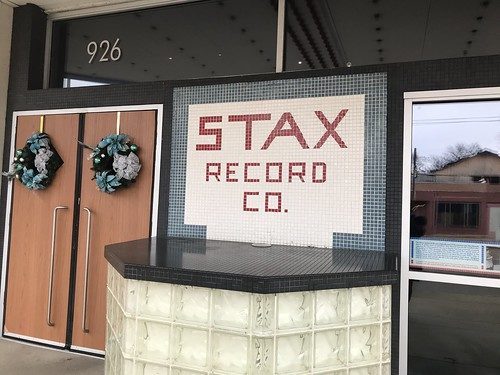You can read more about my Memphis visit starting here. The Stax Museum of American Soul Music was on my list of things to see.
Booker T. & the M.G.’s. Otis Redding. Rufus Thomas. Carla Thomas. The Staples Singers. The Box Tops. Sam & Dave. Albert King. Wilson Pickett. Luther Ingram. Moms Mabley. Jean Knight. Richard Pryor. The Bar-Kays. The Mar-Kays. Steve Cropper. Wayne Jackson. Floyd Newman. Al Jackson Jr. Duck Dunn. Isaac Hayes.
Satellite Records was started in 1957 by Jim Stewart, who worked in a bank as his day job and was a fiddler at night. He did not give up his day job for many years. His sister, Estelle Axton, refinanced her house to move the studio from Brunswick, TN to a former movie theater on McLemore Avenue in the section of Memphis now referred to as Soulsville. Musicians and staff helped turn the theater into a recording studio. The floor’s slant helped deaden the sound. The name was changed to Stax (STewart + AXton) and Estelle opened a record store in the concession stand next door to help with the finances. This paid for the studio for some time. Plus neighborhood people would come by and listen to records (most record shops would not let you listen before you bought) and it gave Estelle a good idea of what people were interested in. Many people walked in, hoping to record, and some of those people turned out to be very good.
In 1960 Atlantic Records became Stax’ distributor, which made them a nationwide label. Black and white musicians would hang out at the Lorraine Hotel during the hottest part of the day – eating fried chicken and swimming in the pool. US and European tours followed. Otis Redding played Monterey and died months later. Dr. Martin Luther King Jr was assassinated at the Lorraine Hotel the following year and Memphis became a different city. Stax Studios was untouched during the riots. Atlantic Records was sold to Warner Brothers and the handshake deal was no good anymore. Warner would not give Jim the original master tapes back, which left Stax in a difficult financial position. Despite losing Sam and Dave, there were plenty of great musicians left. Estelle left and Al Bell was promoted to VP (eventually becoming co-owner with Jim). Bell helped in bringing Stax back. Bell convinced Isaac Hayes (a Stax songwriter and studio musician) and with Hot Buttered Soul, Stax had a new star.
Wattstax – when Stax artists played the Watts Summer Festival in 1972 – became a nationwide hit when the album and documentary came out. Bell was running Stax as more of a business than a community and many musicians were not happy. The IRS started investigating them. CBS backed out of a distribution deal. Without nationwide distribution, Stax crumbled and went into involuntary bankruptcy. The catalog was sold to Fantasy Records. The bank sold the studio to a church in 1981, who was not able to build it into the community center they wanted. Despite protests, the studio was razed and the only thing marking what once was was a marker.
Local leaders formed the Soulsville Foundation to revitalize the surrounding neighborhood, rebuild the Stax Studios as the Stax Museum of American Soul Music and also build the Stax Music Academy and the Soulsville Charter School.
The Satellite Record Shop is now the museum gift store. Before you see the exhibits, they have a short film and then you go behind the screen to see the exhibits. I was there early and it was just me and a few old white people. As the morning went on, more old white people joined us. I was taking my time and enjoying the music and reading the history of the studio, the music, and the musicians. It starts with an old country church that had been moved to the museum. There is a history of gospel and you can listen to various gospel artists. The original equipment when the Jim Stewart started Satellite.
Music surrounds you in this museum. There are a few exhibits with headphones but almost all do not have them. So while you are listening to music in front of one exhibit, you can hear the music coming out of an exhibit a few feet away and maybe more from one further away. For me, it was delightful. I would tune my ear into the one I wanted to hear (sometimes the one in front of me and sometimes not) and pay attention to that song while reading or looking at the exhibit. It was not cacophonous or disturbing at all. It is difficult to describe without making it sound like chaos. There was a section on country music. Blues. The local radio DJs, some of whom later became recording artists. High school bands were how many of the black children in Memphis were able to use and practice on instruments. Many of the musicians thank their HS band teachers for their start.
There are also videos of many of the musicians who worked at or passed through Stax. Many of them are gone now and I am so happy that we have these recorded memories of theirs.
There was a big screen showing Soul Train and you could dance the Soul Train line if you wanted to. One room was filled all the albums and singles recorded at Stax. Stage outfits and road cases. Isaac Hayes’ (real) gold Cadillac. A jukebox where you could choose songs – I chose Margie Joseph’s version of “Stop in the Name of Love.”
They rebuilt Studio A, where so many of Stax’ incredible recordings were made. Even though I knew it was a reproduction, the second I walked into the studio, I burst into tears knowing what had happened in the original room.
This museum is well worth the trip of any music lover, especially if you love soul or rock.
By Carene Lydia Lopez





















